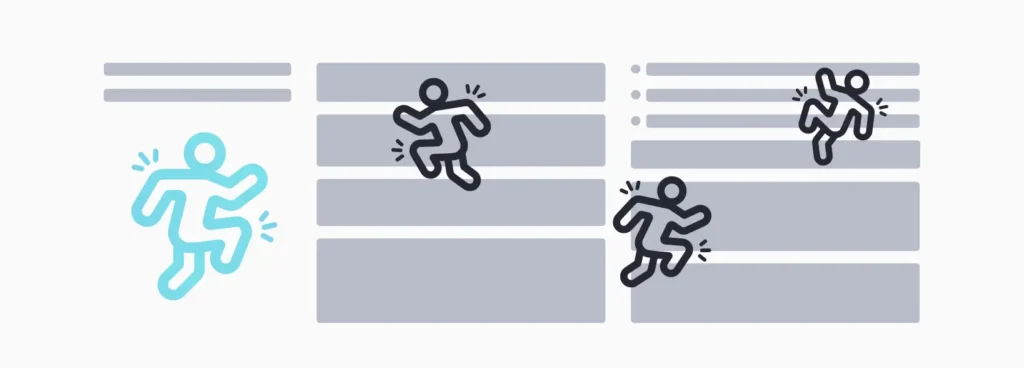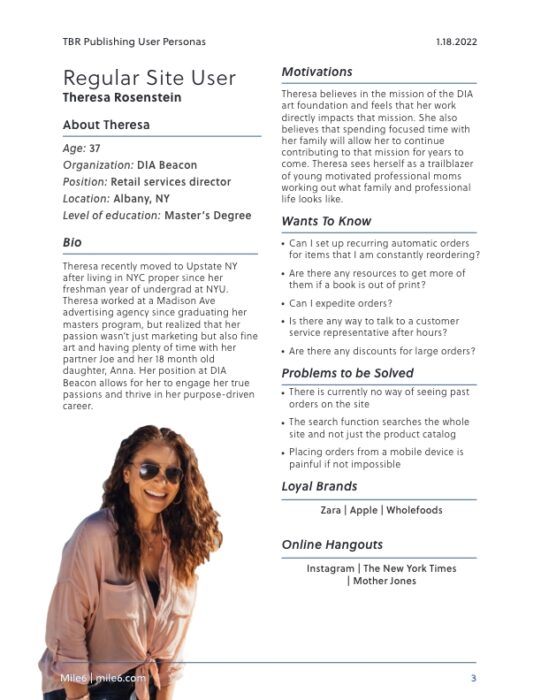A User Persona In Action Through the Digital Product Strategy Phase

If you work with us at Mile6, you probably already know how much we love user personas. We talk about them a lot, and for good reason! They’re an essential part of understanding the users of any digital product we build. We create user personas for every client at the beginning of every new project. If you don’t work in web and application development, you may be looking for a deeper understanding of user personas.
Let’s Make Some Introductions
A user persona is a fictional person that is created to represent a certain demographic user of, in our case, a website, mobile app, or other web application. It’s important to remember that they should not be an actual person that is known to any team member specifically.
User personas contain key details about how a certain group of users tend to behave, what their motivations are, where they engage online etc. They also contain a more intimate profile of who the persons are, things like their level of education, where they live, and details about what could make up their personal life. The point of all of this is to stop us from considering our digital product users as a huge group and help us focus on what an individual user’s experience will be. And as a result, we build a digital product that suits the needs of all users on a personal level to reach their desired outcome.
Nice to Meet U-ser Persona
To illustrate this, we want to show you a user persona and walk you through how we use that persona to direct key decisions around design, technology, and content.
Let’s say a book publisher called TBR Publishing, a medium-sized business that specializes in coffee-table-style books, approaches us to rebuild their current website and client portal. TBR has reached out to us to solve the known issues and uncover additional opportunities for improvement through a site rebuild.
TBR’s current site was built a little over 3 years ago. It’s lean on features and is more or less a marketing placeholder with simple pages that deal with company history, business location, and information on contacting the sales department.
They also have a separate portion of the website with simple ecommerce functionality built in Shopify. The site was put up hastily at the beginning of 2020 to offer products online rather than through retailer partners.
TBR is on the cusp of expansion and is looking to level up, but their site is creating a disjointed workflow and holding them back from their full potential.
After asking the TBR Publishing team very focused and intentional questions, swapping scenarios and stories, and getting to the heart of mutually desired customer and retailer outcomes, we determine what user personas would be the most valuable to create. Below is just one example user persona that we might develop for them.
Meet Theresa Rosenstein! Theresa’s desired outcome is buying books from TBR Publishing for a Museum bookstore.

So, what’s the purpose of getting so detailed again? It helps to humanize our users and allows us to empathize by making them feel real. It also helps the client and our team focus on what is best for users and not make decisions based on our personal preferences.
We will create multiple user personas like this one in a project, representing our client’s different audience segments.
User Personas Walk Through
Now let’s walk through the rest of the project strategy phase with Theresa’s user persona as our decision-making touchpoint.
Evaluating Competitors or Friendlies:
After getting to know the inner workings of TBR Publishing’s industry, we want to compare and evaluate similar businesses. We can utilize Theresa’s user persona while doing this research. Instead of search terms that we would use, let’s put ourselves in Theresa’s shoes and think about what keywords she would search while looking for a book publisher.
Theresa’s perspective is necessary to consider because TBR publishing might use the term “coffee table art books” for their product. In contrast, in her line of work, Theresa might use a search term like “retrospective art books.” The results of these two different searches are similar but produce a few key differences.
Armed with observations like these, we can begin to understand the language and tone we should be using when writing copy, structuring content, and creating interfaces for the user group that Theresa represents.
Evaluating Content & Functionality:
Next, we conduct an exercise to evaluate all current content on TBR Publishing’s website. We also explore what features TBR Publishing wants to expand in their new digital product. Our friend Theresa should stay top of mind while conducting this strategy phase.
We already know that the content for Theresa is lacking on TBR Publishing’s site, but where we need to pay special attention is in developing new concepts and features that serve her as a user. From her persona, we can surmise that she is a regular user of the site and a very high-value one. Theresa is looking for an intuitive way to place large bulk orders. TBR may have never considered their website a place for B2B clients to process bulk orders without using a sales rep, but what an exciting concept!
The features needed for this new process would likely include a robust user interface for B2B clients, an order history section, perhaps a subscription feature so that items consistently selling out every month get reordered automatically. These are all things that we may never have considered if we didn’t see the site from Theresa’s perspective.
Creating a tailored user flow:
At this point in the project, we have a good idea of what our users expect from a visit to the TBR site. For each user persona we create, we generate a user flow through the different parts of the website. Our goal in laying out a user flow is to make as few steps as possible to complete a task and delight users with ideas, content, and functionality.
User flows highlight the ideal user journey, which includes: each page a user might land on, any decision they might make on that page, all optional pages, and their journey’s desired conversion or termination point.
We will split Theresa’s user flow into several different sub-flows. There would likely be a flow for product search, product browsing, product ordering, and a separate flow for navigating a B2B client portal. These are important for us to keep separate because she is likely engaging in these two behaviors in different sessions.
Designing a user-focused experience:
Our final step in the strategy process is to develop wireframes to define the content and user flow. Wireframes are not designs; a wireframe’s purpose is to help project stakeholders to think about the user journey separate from the website visuals.
We can construct the site with her in mind because of our continued focus on Theresa’s motivations and behavior. And if we’ve done our job, it will be an intuitive experience for not just Theresa but all users in her demographic.
Considering Theresa’s persona further, what additional site features will benefit her user experience? Well, we know it must load quickly because Theresa’s schedule is busy, and the line between watching her kids and working from home is probably slightly grey. The site’s product browsing experience should be simple because Theresa may be making purchases on her mobile device. The B2B portal should be robust in functionality and look great on a laptop computer, as that’s the device on which she’s most likely to log in. The impact of the user personas on our decisions for TBR Publishing’s website becomes apparent in this step of the process. At Mile6, this consideration of user experience continues through the design, development, and launch of any new digital product.
Wrap Up
When you consider your users at all project stages, you can create a successful digital product. Starting the project with a thorough user persona creation process sets the solid groundwork and gives all stakeholders a point of reference for decision making. The user persona will be valuable both during and after a digital product is launched – we can’t introduce enough people to user personas!
